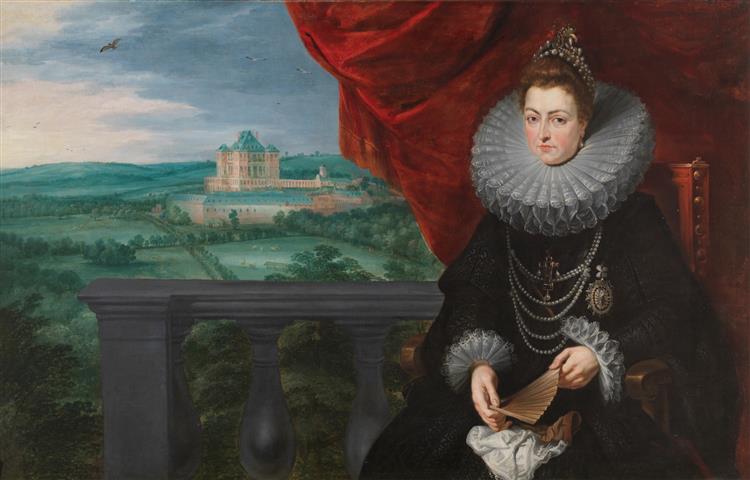Beskrivning
Peter Paul Rubens's "The Infanta Isabel Clara Eugenia", painted in 1615, stands as a prime example of the artist's mastery in depicting European nobility and royalty. Rubens, a 17th-century Flemish painter, is known for his Baroque style, characterized by its dynamism, exuberant use of color, and ability to convey the vibrant energy of his characters. In this painting, the direct and immersive approach to his subject embodies the artist's talent for capturing the essence of nobility through paint.
Infanta Isabel Clara Eugenia, daughter of King Philip II of Spain and his third wife, Queen Isabella of Portugal, is portrayed with a magnetic presence that exudes dignity and authority. The young figure, clad in a finely detailed gown displaying sophisticated and luxurious gold latticework, complements the opulence of her surroundings. Rubens’ chosen colour palette, which ranges from golden hues to deep burgundies to clear whites, emphasises not only the Infanta’s material wealth but also her privileged position at court.
The background, a landscape that appears behind the central figure, provides a subtle depth to the composition, alluding to a connection with nature that complements Isabel Clara Eugenia's aristocratic elegance. Through a skillful use of light and shadow, Rubens manages to model the figure of the Infanta, providing volume and three-dimensionality that make the portrait transcend the typical two-dimensionality of the canvas.
It is no surprise that Rubens, an expert in portrait painting and with a narrative approach in his works, creates a picture full of meaningful details. The Infanta's elaborate hairstyle, adorned with jewels, highlights her youth and status. The viewer's gaze is drawn both to the Infanta's serene and determined expression and to her firm posture, which conveys a sense of confidence and dependence on the lineage to which she belongs.
Although no other figures are seen in the composition, the mere presence of Isabel Clara Eugenia speaks of the social and political significance of her figure in the Europe of her time. The Infanta was not only a noble figure, but also a symbol of the dynastic alliances that defined European politics. Her depiction by Rubens can also be seen as an attempt to reinforce the honour and prestige of the House of Austria, through the visual capture of her offspring.
Rubens' painting technique, marked by his loose and dynamic brushwork, suggests movement and life both in the textures of the costume and in the gestures of his central figure. Each fold of the dress seems to move with the Infanta, almost as if captured in action, which is characteristic of the painter's style. Through this work, Rubens not only documents the appearance of a young aristocrat, but also investigates the role of portraiture as a vehicle of power and status in Baroque society.
In short, The Infanta Isabel Clara Eugenia stands as a masterpiece within Rubens' oeuvre, allowing viewers to enter the world of 17th-century aristocracy. The artist's ability to channel the essence of the subject, along with his mastery of color and composition, offers a window into the rich social and historical tapestry of his time. This portrait not only captures the Infanta, but also the grandeur and complexity of an era marked by magnificence and political intrigue, encapsulating in a single canvas the vitality of Baroque culture and the enduring fascination with the depiction of the powerful.
KUADROS ©, a famous painting on your wall.
Hand-made oil painting reproductions, with the quality of professional artists and the distinctive seal of KUADROS ©.
Painting reproduction service with satisfaction guarantee. If you are not completely satisfied with the replica of your painting, we will refund 100% of your money.

